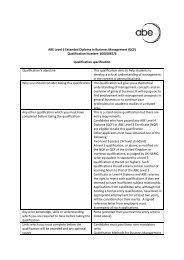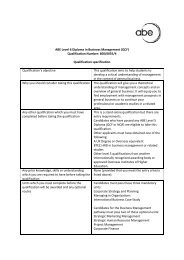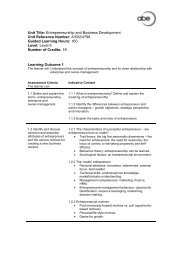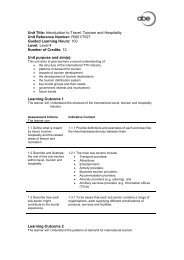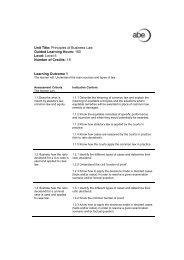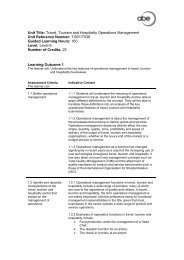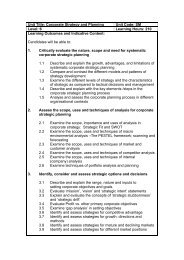Chapter 5 Business Planning and Enterprise Start-up
Chapter 5 Business Planning and Enterprise Start-up
Chapter 5 Business Planning and Enterprise Start-up
You also want an ePaper? Increase the reach of your titles
YUMPU automatically turns print PDFs into web optimized ePapers that Google loves.
69_________________________________________________________________________________________<strong>Chapter</strong> 5<strong>Business</strong> <strong>Planning</strong> <strong>and</strong> <strong>Enterprise</strong> <strong>Start</strong>-<strong>up</strong>ContentsPageIntroduction 70A. The Importance of <strong>Business</strong> <strong>Planning</strong> 71Focusing the Ideas for a New <strong>Business</strong> 72Setting Goals <strong>and</strong> Targets 73Measuring Progress <strong>and</strong> Achievement 73An Ongoing Management Tool 75B. Expectations of Lenders <strong>and</strong> Investors 76Raising Finance for <strong>Start</strong>-<strong>up</strong> or Expansion 76The Differing Objectives of Lenders <strong>and</strong> Investors 76What Do Lenders <strong>and</strong> Investors Expect from a <strong>Business</strong> Plan? 77Due Diligence 78C. <strong>Business</strong> Plan Format <strong>and</strong> Structure 78Generic <strong>Business</strong> Plan Format 78How Much Detail Should the <strong>Business</strong> Plan Contain? 80D. <strong>Planning</strong> <strong>and</strong> Funding High-tech <strong>and</strong> High-growth <strong>Start</strong>-<strong>up</strong>s 81Summary of Main Factors 81Bibliography 82_________________________________________________________________________________________© ABE
<strong>Business</strong> <strong>Planning</strong> <strong>and</strong> <strong>Enterprise</strong> <strong>Start</strong>-<strong>up</strong> 73_________________________________________________________________________________________depth of knowledge of the product or service. These are factors that banks <strong>and</strong> investors willconsider <strong>and</strong> explore as part of their evaluation of a proposal.Setting Goals <strong>and</strong> TargetsThe finance <strong>and</strong> marketing sections of a business plan are where the performance targets ofthe business are set, <strong>and</strong> this will be explained in more detail in later chapters. The purposeis to establish parameters <strong>and</strong> specific targets that provide a yardstick against which theprogress <strong>and</strong> profitability of the business can be measured. These targets will typically beexpressed in terms of quantifiable numbers <strong>and</strong> financial figures that will form the budgetaryplan for the business.Essentially, the process involves forecasting expected sales in terms of target numbers foreach month or quarter <strong>and</strong> for the year as a whole. The sales forecast numbers are used togenerate revenue forecasts <strong>and</strong> the estimated costs of producing <strong>and</strong> delivering those salesto the customer. The difference between these two is the forecast gross profit margin, which,after overhead costs are subtracted, will provide the actual net profit forecasts that willdetermine whether or not the business has exceeded its break-even level of trading.The process is relatively simple, but these forecasts are only as good as the accuracy of theinformation on which they are based. It is imperative that the prospective entrepreneur treatsthis process very seriously, attempts to make the figures as detailed <strong>and</strong> accurate aspossible, <strong>and</strong> can justify the figures <strong>and</strong> underlying assumptions when challenged by apotential lender or investor. This is probably the part of the business plan that first-timeentrepreneurs find most difficult; however, once the importance <strong>and</strong> value of the process areunderstood, the entrepreneur will find the forecasts easier to produce as a regular <strong>and</strong>essential part of the process of running the business.For new businesses, the process is always particularly difficult as there is no historicalperformance data on which to base these forecasts. For this reason, many businesses preferto prepare two forecasts that enable them to compare worst case <strong>and</strong> best case scenarios.These are particularly useful where sales or market conditions are volatile as they enable theentrepreneur to see when they could be facing problems – for example, in worst casesituations where remedial actions or cost-cutting may be needed, or if sales are higher thanexpected, where the increased level of trading may create potential pressure on cash flow orworking capital.Measuring Progress <strong>and</strong> AchievementAs explained earlier in this chapter, it is imperative that every new business has clearlydefined objectives <strong>and</strong> parameters within which it will operate, but these only have purpose<strong>and</strong> value if they can be used as a basis for measuring the performance of the business onan ongoing basis.To achieve this, the objectives have to be broken down <strong>and</strong> expressed as a series of specificmeasurable targets for each key performance area of the business. Here are some examplesfrom the financial context.• Annual budgetary plans, forecasting income <strong>and</strong> expenditure on a month by monthbasis, against which actual income <strong>and</strong> expenditure can be monitored._________________________________________________________________________________________© ABE
74 <strong>Business</strong> <strong>Planning</strong> <strong>and</strong> <strong>Enterprise</strong> <strong>Start</strong>-<strong>up</strong>_________________________________________________________________________________________• Forecasts of gross profit margins <strong>and</strong> net profit margins, derived from the budgetaryplans, which can be monitored to pick <strong>up</strong> any problems due to rising costs, fallingsales, or seasonal fluctuations in sales, etc.• The effects of specific sales or promotional activities on sales revenues or profitmargins.• Cash flow forecasts, <strong>and</strong> the effects of giving or taking credit.• The need for additional working capital to sustain the business, e.g. by means ofshort-term overdrafts or longer-term loans to facilitate expansion of the business.• Affordability of capital investment. Do we replace or repair? Do we producecomponents ourselves, or buy them in? Do we use loans or hire purchase to buyequipment, or do we lease?Here are some examples from the resources context.• Identify the physical resources needed by the business to start <strong>up</strong> <strong>and</strong> operateefficiently.• Identify the additional resources needed as the business grows, <strong>and</strong> when they will berequired.• Ensure that resources are being used efficiently <strong>and</strong> at optimum capacity so that theygenerate a good return on their investment costs.• Plan the staff requirements <strong>and</strong> associated costs to ensure that there are sufficientstaff with the right skills mix available when they are needed.Finally, here are some examples from the sales <strong>and</strong> marketing context.• Forecasts of market share that will be achieved by each range of products or services.• Sales forecasts <strong>and</strong> projected revenues for each individual product or service.• Expected profit margins or contributions to overheads achieved by those revenues.• The costs of sales activities to exp<strong>and</strong> the customer base <strong>and</strong> volume of sales toindividual customers.• Costs of special promotions <strong>and</strong> expectations of increased sales <strong>and</strong> revenuesgenerated by them.• Costs of customer service <strong>and</strong> retention.The planning <strong>and</strong> monitoring of progress <strong>and</strong> achievement are integral parts of the ongoingmanagement of business operations. The initial business idea formulates the initial policiesthat determine the financial <strong>and</strong> marketing plans <strong>and</strong> targets, <strong>and</strong> the achievement (orotherwise) of those targets. Those plans <strong>and</strong> policies may need to be modified in response toexternal influences <strong>and</strong> changes, <strong>and</strong> that may influence the resources available for thefuture, which in turn impacts on future business planning. This is the constant cycle of:• plan• implement• monitor• revise.Ideally, of course, any revisions should take the form of proactive plans made in anticipationof future changes <strong>and</strong> events, rather than as a series of reactions in response to past eventsor circumstances. It is important for the business to control these changes rather than beingcontrolled by them._________________________________________________________________________________________© ABE
<strong>Business</strong> <strong>Planning</strong> <strong>and</strong> <strong>Enterprise</strong> <strong>Start</strong>-<strong>up</strong> 75_________________________________________________________________________________________An Ongoing Management ToolMost business plans are <strong>up</strong>dated on an annual basis. For most small firms, it is unrealistic toprepare very detailed budgets <strong>and</strong> cash flow forecasts more than a year ahead, <strong>and</strong>preparing them for less than a full year would be too short a time to generate usefulinformation. It is important to remember that the business plan is a live document to be usedas part of the ongoing process of managing the business – it is not just something preparedfor the bank manager at the start of the year, <strong>and</strong> then put in the filing cabinet <strong>and</strong> forgottenuntil next year. Most firms revise their plans quarterly or at the half-year stage if it looks likethere will be any major changes happening that might affect their original forecasts. Forexample, a fall in product dem<strong>and</strong> will reduce sales revenue, so costs may also need to betrimmed back to maintain profitability. In contrast, if sales are significantly higher thanforecast, the budgets will need to be adjusted to reflect not just the increased revenue, butalso the associated increases in costs of production or distribution.Plans need to be monitored on a regular <strong>and</strong> frequent basis if they are to be of anyproductive use. Budget outcomes (actual figures) should be compared with forecast figuresat least once each month, <strong>and</strong> then within two weeks of the end of the month. This willenable prompt identification of any major discrepancies or problems which lie on the horizon.When discrepancies occur, they must be questioned.• Why has this happened?• Is it a one-off occurrence, or the start of a longer-term trend <strong>and</strong> potential problem?• What has to be done to resolve the situation?Unfortunately, when faced with apparent problems, too many people are more concernedwith the question of who is to blame than with identifying the cause of the problems <strong>and</strong>working to find a solution. The subject of financial monitoring <strong>and</strong> control will be examined inmore detail in <strong>Chapter</strong> 11.One other aspect to be considered here is the fundamentally different approaches toplanning by small firms <strong>and</strong> their larger counterparts. Small firms, <strong>and</strong> especially those at anearly stage, rarely follow the structured <strong>and</strong> defined approaches of management that areused by big companies – the traditional big company model of management <strong>and</strong> careerdevelopment simply cannot be applied to small businesses. Larger organisations normallyhave the resources, stability <strong>and</strong> security to facilitate long-term strategic planning, typicallythree to five years ahead, <strong>and</strong> the immediate year ahead is seen as the short term. Forentrepreneurs or owner-managers of small firms, the immediate problem is often simply acase of day to day survival – i.e. where is the next order coming from? This is particularly truein the early stages of the business, when planning just six months or a year ahead counts aslong term. In the early stages, most small firms focus on short-term plans <strong>and</strong> goals with cashflow <strong>and</strong> survival as their main priorities. This means that they will invariably look to theequally short-term actions <strong>and</strong> policies that will enable them to meet those short-term goals.As discussed in Section B of <strong>Chapter</strong> 3, only when they have achieved some measure ofstability <strong>and</strong> security can they start to look at longer-term planning <strong>and</strong> investment._________________________________________________________________________________________© ABE
76 <strong>Business</strong> <strong>Planning</strong> <strong>and</strong> <strong>Enterprise</strong> <strong>Start</strong>-<strong>up</strong>_________________________________________________________________________________________B. EXPECTATIONS OF LENDERS AND INVESTORSRaising Finance for <strong>Start</strong>-<strong>up</strong> or ExpansionFew start-<strong>up</strong> businesses are in the fortunate position of not having to raise funds to starttrading – for example, if they have savings or other cash they can use – <strong>and</strong> virtually all ofthose who have ambitions of growth for the future will need some form of finance to exp<strong>and</strong><strong>and</strong> grow. In most European countries, even those not requiring start-<strong>up</strong> funding are usuallyasked by their bank to provide a basic business plan in order to qualify for an initial period(usually the first year of trading) of free bank charges on their business accounts.The various options for raising business finance are discussed in Section E of <strong>Chapter</strong> 11,but for the majority of small firms, the starting point is their local bank manager. Inevitably,the first question asked of a budding entrepreneur is: “Can I see your business plan?” This isusually closely followed by: “What forms of security or collateral can you offer?” Obtainingstart-<strong>up</strong> funding from banks has never been easy but since the credit crunch that started in2008 <strong>and</strong> particularly affected the USA <strong>and</strong> Europe, many start-<strong>up</strong>s are finding it almostimpossible as the banks become increasingly risk averse. This is particularly true of anumber of major lending banks that had to be nationalised in 2008-09 because of theirprofligate lending in the previous few years, when it was easy for anyone who had areasonable amount of security to borrow money to start a new business.Today, the clearing banks take a much more responsible (<strong>and</strong> risk-averse) attitude topotential business customers, seeing themselves as stakeholders in the businesses. This isreflected in the questions they ask, <strong>and</strong> the risk analysis process they use to review theviability of new business proposals.The ability to prepare a comprehensive <strong>and</strong> coherent business plan is an imperative foranyone starting in business, particularly if finance is required from outside of the business.The UK Government’s VAT registration statistics suggest that only half of new businessessurvive more than five years, so a strong business plan will not only make raising funds lessdifficult, it should also make the proposition more likely to succeed. Preparing a plan for abank is not difficult, given the many st<strong>and</strong>ard formats that are available. However, it isimportant that the content of the plan is not just about satisfying the bank manager’sinformation requirements; it should also provide the entrepreneur with the knowledge <strong>and</strong>information needed to ensure the business can survive the difficult early stages to becomeprofitable <strong>and</strong> grow. For that reason, the st<strong>and</strong>ard business plan formats required by banksshould not be regarded as sufficient, as they frequently lack the essential information thatentrepreneurs need to survive <strong>and</strong> succeed. For this reason, a more comprehensivebusiness plan format is included in this chapter.The Differing Objectives of Lenders <strong>and</strong> InvestorsIt is important for potential entrepreneurs to be aware of the differences in objectives <strong>and</strong>expectations that lenders <strong>and</strong> investors have when they provide funding to businesses, asthis can influence the way they pitch their business proposals to either provider._________________________________________________________________________________________© ABE
<strong>Business</strong> <strong>Planning</strong> <strong>and</strong> <strong>Enterprise</strong> <strong>Start</strong>-<strong>up</strong> 77_________________________________________________________________________________________Lenders, especially the conventional lending banks, are essentially managing funds that theyhave obtained from investors, savers or their own institutional profits. They have to be seennot only to invest those funds prudently but to achieve a certain level of return for their savers<strong>and</strong> investors. They are, therefore, looking to lend money at minimal risk, with theexpectations of repayment over a fixed period of time along with a pre-defined level of profitfrom accrued interest. Even for low-risk ventures, they may typically expect security,collateral or directors’ guarantees against any losses, possibly in the region of 2:1 coverage.They will want to see investment from the entrepreneur, preferably matching the sums theyare being asked to provide, although they also look favourably on proposals that ares<strong>up</strong>ported by independent private investors. They also expect the companies to provide themwith regular progress reports, <strong>and</strong> warnings of any problems arising.In contrast, most private investors are using their own money. They accept balanced ormeasured risk, knowing that any new business is inherently risky, accepting the risk if thepotential return on their investment is sufficiently high, <strong>and</strong> also knowing that it may takeseveral years to achieve. Their profit may be partially achieved by the payment of dividendsfrom company profits, but not always as what they are really looking for is capital growth inthe value of the business. They look to exit the business after an agreed period of time whenthey will sell their shareholding back to the entrepreneur or perhaps to a third party for amuch higher price that they invested. This will reflect the increased capital value – perhaps inthe region of 25% of the value of their investment for each year of the investment – to reflectthe risks they have taken. They may also want to be represented in the management of thebusiness. Some entrepreneurs might regard this as interference, but it can contributevaluable business experience.The one common factor that is shared alike by entrepreneurs, lenders <strong>and</strong> investors is theneed to pick winning ideas. Entrepreneurs need to pick winners to be successful; investorswant winners (as opposed to losers or partial successes) to achieve the high level of capitalgrowth that will give them a good return on their investment; <strong>and</strong> bankers just want to gettheir money back with interest. The process of identifying winning propositions is explained in<strong>Chapter</strong> 4.What Do Lenders <strong>and</strong> Investors Expect from a <strong>Business</strong> Plan?When experienced lenders or investors take a first look at a new business plan proposal,they rarely read it through from front to back. Typically, they will skim over the introduction toget an idea of what the proposal is about <strong>and</strong> then jump straight to the finance section to lookat the profit <strong>and</strong> revenue forecasts for the first two years. If they are comfortable with that,they will move on to examine the marketing section to gain an underst<strong>and</strong>ing of the realism ofthe marketing proposals. Only if they are satisfied with this will they bother to read theproposal in detail, <strong>and</strong> even then there are usually many questions that need to be answeredbefore they reach the stage of being ready to make a decision about whether or not to lend orinvest.Essentially, when reviewing a proposal, investors <strong>and</strong> lenders are looking for answers to anumber of specific questions.• How financially viable does the business proposal look, <strong>and</strong> what is the likelihood of aloan being repaid, or making a good return on capital investment (viainterest/dividends/capital growth)? Does this constitute an acceptable level of risk?• How reasonable are the sales <strong>and</strong> profit forecasts <strong>and</strong> projections – do the figureslook realistic?_________________________________________________________________________________________© ABE
78 <strong>Business</strong> <strong>Planning</strong> <strong>and</strong> <strong>Enterprise</strong> <strong>Start</strong>-<strong>up</strong>_________________________________________________________________________________________• Do the proposals demonstrate a good degree of underst<strong>and</strong>ing <strong>and</strong> analysis ofmarkets <strong>and</strong> customers? Is this s<strong>up</strong>ported by market research information?• How detailed <strong>and</strong> realistic is the marketing plan?• How strong are the skills, experience <strong>and</strong> competences of business proposers? Doesthe business have a strong management team?• How realistic is the timescale for implementation? If the timescale is protracted, isthere a risk of the business failing to get started?• Do the proposers underst<strong>and</strong> their break-even position – in terms of units sold, orsales revenue, or time taken to reach break-even? Is there enough working capital inthe proposed budget to enable the business to reach break-even before it runs out ofmoney?• Has a detailed risk analysis been carried out, <strong>and</strong> have contingency plans beenidentified to address or mitigate risks?• What opportunities have been identified for investors to exit at the end of theinvestment period (exit strategies)?Due DiligenceDue diligence is the process used to evaluate business proposals for lending or investment.In its simplest form, for a start-<strong>up</strong> business, it may comprise a detailed risk analysis of theproposed borrowing against the business plan, co<strong>up</strong>led with checks on the financial positionof the proposers – taking <strong>up</strong> bank <strong>and</strong> personal references; carrying out credit checks;insolvency list searches; <strong>and</strong> property searches where property is offered as security, etc.The process can also include the drafting of formal terms of agreement between theinvestors <strong>and</strong> the entrepreneurs.Where substantial borrowing or investment is required, e.g. for staged funding of high-growthcompanies, the due diligence process will be much more complex. It might include searches<strong>and</strong> reports from the Registrar of Companies, references from s<strong>up</strong>pliers, dialogue withcustomers, patent searches <strong>and</strong> checks on licences or other IP, market analysis reports,reviews of published articles relating to company research projects, <strong>and</strong> detailed scrutiny oftechnical processes by independent experts. All of these items can involve a great deal oftime, effort <strong>and</strong> expense which is why a lot of venture capital investors will not even considerinvestments under several million pounds.C. BUSINESS PLAN FORMAT AND STRUCTUREGeneric <strong>Business</strong> Plan FormatThe following generic business plan format is an <strong>up</strong>date of a model developed by Butler(2006) that has been designed to cover the content required to meet three specificobjectives.1. It has been synthesised from a number of business plan formats used by major UKclearing banks (HSBC/Barclays/Lloyds TSB/RBS etc) <strong>and</strong> modified to provide thecontent <strong>and</strong> coverage required by most lenders <strong>and</strong> investors to enable them to makea balanced decision about providing funding for the business proposal.2. It follows the Small Firms <strong>Enterprise</strong> Development Initiative (SFEDI) NationalOcc<strong>up</strong>ational St<strong>and</strong>ards for <strong>Business</strong> <strong>Enterprise</strong>, which define best practice for the_________________________________________________________________________________________© ABE
<strong>Business</strong> <strong>Planning</strong> <strong>and</strong> <strong>Enterprise</strong> <strong>Start</strong>-<strong>up</strong> 79_________________________________________________________________________________________business planning process <strong>and</strong> form the basis for many qualifications. SFEDI(www.sfedi.co.uk) is the Sector Skills Body for <strong>Enterprise</strong> in the UK.3. Most importantly, the plan’s content <strong>and</strong> structure should require the potentialentrepreneur to underst<strong>and</strong> <strong>and</strong> address a range of key questions <strong>and</strong> issues that areessential to survival during the start-<strong>up</strong> <strong>and</strong> early stages of a new businessThis format is intended to be generic, in that it covers a very broad range of content thatmight possibly be required for a potential new start-<strong>up</strong> business, but not all aspects will berelevant to all start-<strong>up</strong>s. This is explained in the following section of this chapter in moredetail, <strong>and</strong> the content of each section of the business plan format will be explained in muchmore depth in subsequent chapters.1 THE BUSINESS IDEA (introduction/executive summary of business plan)1.1 Brief outline of type of business proposed <strong>and</strong> trading status1.2 Range of services to be offered (primary products/services, <strong>and</strong> secondary servicesthat generate additional or ancillary revenue)1.3 Personal parameters of owners, e.g. full-time or part-time business operation, hobbybusiness, lifestyle factors <strong>and</strong> influences, time constraints or physical ability1.4 Geographical location of business/operating area (e.g. local, regional, national, orinternational)1.5 Brief summary of anticipated customers/target market <strong>and</strong> their distribution1.6 Statement of viability – why I/we will succeed with business proposal2 THE BUSINESS PROPOSER(S)2.1 Brief background/personal history/summary CV of key team members2.2 Personal influences, ambitions <strong>and</strong> long-term objectives of the proposer(s)2.3 Why I/we want to go in to business2.4 Personal skills, expertise <strong>and</strong> experience relevant to business2.5 SWOT analysis, <strong>and</strong> identification of personal development needs3 RESOURCES REQUIRED3.1 Costed start-<strong>up</strong> inventory of equipment <strong>and</strong> materials3.2 List of equipment/materials already available3.3 Details of any IPR owned/applied for3.4 Premises requirements <strong>and</strong> any modifications required?3.5 Transport requirements/availability3.6 Staff <strong>and</strong> skills requirements in early stages (if needed)4 FINANCE4.1 Spreadsheet(s) showing first year budgetary plan <strong>and</strong> cash flow forecast4.2 Explanation of basis for planned budget4.3 Personal survival budget – to determine owners’ salaries/drawings4.4 Break-even analysis – in terms of timescale/revenue/units sold4.5 Profit forecasts for years one <strong>and</strong> two4.6 Value of current resources/capital available/investment to date4.7 Further finance required (<strong>and</strong> phasing if appropriate)4.8 Potential sources of finance – loan capital/equity options4.9 Preferred sources of finance <strong>and</strong> reasons for choice4.10 Financial monitoring procedures within business_________________________________________________________________________________________© ABE
80 <strong>Business</strong> <strong>Planning</strong> <strong>and</strong> <strong>Enterprise</strong> <strong>Start</strong>-<strong>up</strong>_________________________________________________________________________________________5 MARKETING5.1 Detailed description of target market <strong>and</strong> operating area5.2 What is special/unique about my/our services, or how do they differ from those offeredby my competitors?5.3 Market research carried out <strong>and</strong>/or further research planned5.4 Description of relevant seasonal factors <strong>and</strong> other influences5.5 Analysis of competitors’ services, activities, prices etc5.6 Marketing plan5.7 Schedule of fees <strong>and</strong> charges for products or services5.8 Statement of quality st<strong>and</strong>ards <strong>and</strong> customer service policies, <strong>and</strong> how these will bemonitored to maintain <strong>and</strong> improve services5.9 Monitoring of sales, <strong>and</strong> changes in marketing trends6 IMPLEMENTATION AND MONITORING (describe the following)6.1 Chosen means of operation (limited company/sole trader/partnership/communityinterest company etc), <strong>and</strong> reasons for choice6.2 Maintaining compliance with relevant legislation (including brief summary of why otherkey legislation may not be relevant) – e.g. health <strong>and</strong> safety/data protection6.3 Timetable <strong>and</strong> phasing of start-<strong>up</strong> (including pre-start-<strong>up</strong> R&D/proof of conceptactivity, if relevant)6.4 Identification of key/critical stages of implementation, with risk analysis including keytasks, potential delays etc, <strong>and</strong> contingency plans for dealing with problems6.5 Longer-term objectives for business once established, <strong>and</strong> exit strategy if relevant6.6 How success of business will be measured7 SUMMARY7.1 Re-affirm reasons for viability <strong>and</strong> expected success of proposal8 APPENDICES (other information s<strong>up</strong>porting plan)8.1 Letters of intent/s<strong>up</strong>port from potential customers/s<strong>up</strong>pliers8.2 Market research data8.3 Estate agents’ information on potential business premises8.4 Design material/copyrights/patent information (if relevant)8.5 Technical product information8.6 Detailed CVs of proposers <strong>and</strong>/or associates8.7 Samples of advertising material, leaflets, business cardsHow Much Detail Should the <strong>Business</strong> Plan Contain?The amount of detail a business plan should contain will very much depend on the type ofbusiness for which the plan is being prepared. For example, a self-employed window cleanerwith no overheads or equipment apart from a car, ladders, a bucket, chamois <strong>and</strong> scraper willhave quite simple requirements – in fact, the biggest problem will probably be planning whereto get the clean water from, on each part of the daily round. In comparison, someone setting<strong>up</strong> a wholesale or manufacturing business, or as a hotelier, an import/export agent, or aspecialist holiday tour operator, where longer-term capital funding is required or wherespecific <strong>and</strong> possibly complex legislation applies, may have quite a detailed business plan.Some self-employed people who have no need of external funding simply do not bother toprepare business plans. Others working on a part-time basis may have a very simple plan, asthey may not depend on that particular business activity as their sole source of income (for_________________________________________________________________________________________© ABE
<strong>Business</strong> <strong>Planning</strong> <strong>and</strong> <strong>Enterprise</strong> <strong>Start</strong>-<strong>up</strong> 81_________________________________________________________________________________________example, part-time hairdressers or book-keepers who have another regular day job orperhaps a working spouse or domestic partner who also has an income). Hence, the size <strong>and</strong>content of any particular business plan will depend on the type of business it relates to, theborrowing requirements, <strong>and</strong> the personal circumstances <strong>and</strong> resources of the entrepreneuror owner-manager.As explained, the business plan format shown in the previous section of this chapter isintended to be generic. It contains just about all the types of information that someone who isstarting a new enterprise may need to provide for a lender or investor if they need to raisemoney. It also covers the range of information a new entrepreneur will need to know tosurvive. However, this does not mean that every part of the generic format will be relevant toevery business.If the business proposal does not require funding from external lenders or investors, thebusiness plan could be much less formal, <strong>and</strong> the information in it could be less detailed.However, that should not be used as an excuse to not prepare a plan. Although the planningexercise may be regarded as tedious or a waste of time by people who are keen to get theirbusiness started, it is still a very valuable exercise in providing the knowledge <strong>and</strong>information required to help the business to succeed. In particular, the market research,financial <strong>and</strong> budgetary planning, break-even analysis, <strong>and</strong> risk analysis are all essential prestart-<strong>up</strong>activities that nobody should ignore.D. PLANNING AND FUNDING HIGH-TECH AND HIGH-GROWTHSTART-UPSSummary of Main FactorsHere is a summary of the key aspects of planning <strong>and</strong> funding high-tech <strong>and</strong> high-growthstart-<strong>up</strong>s (covered in more detail in <strong>Chapter</strong> 4).• High-tech <strong>and</strong> high-growth-potential start-<strong>up</strong>s will usually require a more sophisticatedmanagement team that can provide a high level of expertise in sourcing finance <strong>and</strong>investments, managing substantial budgets, <strong>and</strong> national or international marketing,product licensing experience, strong management <strong>and</strong> leadership skills, <strong>and</strong> specialisttechnical knowledge, often co<strong>up</strong>led with research <strong>and</strong> product developmentexperience.• Such companies will often take a number of years to reach the revenue generationstage, <strong>and</strong> en route to that will require successive stages of funding from potentiallydifferent sources – R&D grants, proof of concept funds, pre-market productdevelopment finance, market launch funding, subsequent seed or accelerator fundsfor growth, <strong>and</strong> longer-term, potentially large-scale investment for expansion. Forbiotechnology companies, it can often take five or six years to get a new product readyfor market, <strong>and</strong> longer if international medical authorisations are required.• The typical capital investment costs of starting <strong>up</strong> will be higher for technology-basedinnovations, <strong>and</strong> may have to be obtained from a range of different sources over aperiod of several years.• The working capital requirements for funding rapid growth will be much higher for highgrowth-potentialbusinesses than for conventional firms that fund incremental growthfrom profits._________________________________________________________________________________________© ABE
82 <strong>Business</strong> <strong>Planning</strong> <strong>and</strong> <strong>Enterprise</strong> <strong>Start</strong>-<strong>up</strong>_________________________________________________________________________________________• There may be a need for costly protection of IPR, <strong>and</strong> where the innovation isgenerated from an academic research source, those rights (or a proportion of theequity of the business) may have to be shared.BIBLIOGRAPHY• Butler, D. (2006) <strong>Enterprise</strong> <strong>Planning</strong> <strong>and</strong> Development: Small <strong>Business</strong> <strong>Start</strong>-<strong>up</strong>,Survival <strong>and</strong> Growth. Oxford: Elsevier Butterworth-Heinemann• Williams, S. (2012) The Financial Times Guide to <strong>Business</strong> <strong>Start</strong>-<strong>up</strong> 2013. London:Financial Times_________________________________________________________________________________________© ABE





